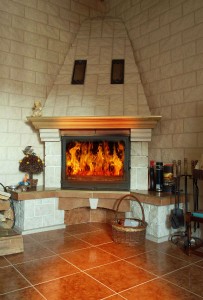With high temperatures at the beginning of November only scraping the high fifties in Seattle, the fall season is in full swing. Shorts and sandals are being swapped out for jackets and gloves, and everyone is looking ahead to winter and thinking of ways to stay warm. For some homeowners, part of staying warm could involve lighting up the fireplace or wood stove. That means scheduling the annual chimney sweep and inspection before using the fireplace too much. During this year’s annual inspection, ask the chimney specialist about the damper in your fireplace. The major responsibilities of this seemingly simple apparatus may surprise you.
The damper is a flap found at either the bottom or top of the flue, and it is generally made of ceramic or stainless steel to withstand the high heat of the fire. It moves using a pull chain, handle or latch, and its main function is to control air flow in and out of the chimney.
This simple mechanism is one of major contributing factors to the draft of the chimney. The draft is essentially the flow of air from the inside of the house, into the fire, and up the chimney. When a fire is lit, the hot air tends to rise because it is less dense than the cold air outside. The pressure differential creating by this initial burst of hot air creates the draft, which can be imagined as an upward “pull” of the air in the chimney. This force directs the smoke from the fire out of the chimney, and in turn, it pulls the highly oxygenated air from the house into the fire, which results in a hot, efficient fire. All of this physics and air flow comes down to how wide the damper is open. A too wide damper could take all the hot air right out the chimney, or it could deplete the oxygen levels to the point where the fire burns out. On the other hand, an overly narrow damper opening could cause the draft to go in reverse, essentially filling the house with smoke and eventually extinguishing the flame.
How the damper is positioned also affects the fire. A damper at the bottom of the flue, right above the firebox, is easy to see and open. However, it keeps the majority of the chimney cold when the fireplace is not in use, so starting the fire is much slower. The hot air has to push past much more cold air, and starting too large of a fire initially could result in a smoky house. Conversely, a damper at the top of the flue means the chimney stays warmer, so it takes much less time to start a large, hot fire. However, this damper position also makes it hard to keep an eye on the condition and the width of the opening of the damper.
In contrast to their relatively simple construction and mechanism, dampers actually play a huge role in the efficiency of the fire and in keeping the house safe and smoke-free. During your next inspection, be sure to check with the inspector to learn where your damper is and how to safely use it. If you live in the Seattle area, you can contact Pristine Sweeps to speak with a chimney professional.

